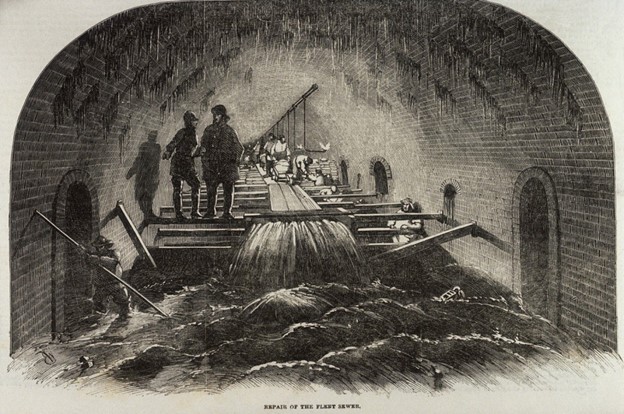Contrary to the claims of the pharmaceutical industry, the spread of disease was not lessened by vaccines and drugs but by hygiene, indoor plumbing, and underground sewer systems. Drugs can be very useful when it comes to pain control, surgery, injuries caused by accidents, shootings, fires, and other kinds of trauma. But drugs cannot cure disease, only suppress symptoms and cause harmful side effects. Vaccines have killed and harmed millions of people since they were first invented. They certainly have nothing to do with preventing disease.
Before the advent of modern plumbing, urban centers were breeding grounds for disease. Waste disposal was rudimentary at best, with human excrement often disposed of in streets or open cesspits, contaminating water supplies and creating unsanitary living conditions. This lack of proper sanitation facilitated the spread of waterborne diseases such as cholera, dysentery, and typhoid fever.
The 19th century marked a turning point in public health with the recognition of the link between sanitation and disease. The pioneering work of John Snow, the founder of epidemiology, who traced a cholera outbreak in London in 1854 to a contaminated water pump, highlighted the critical need for clean water and effective waste disposal. As reported in the JSTOR Daily – “During an earlier cholera outbreak in London, Snow wondered how the “blue death”—so called because of the blue tinge of the victims’ skin—spread. In an 1849 monograph, he postulated that cesspools might be spreading human waste to drinking water. This idea was met with scorn. For several years he mapped past incidences of the disease, compared neighborhoods and neighbors, and virtually invented epidemiology.
When the 1854 epidemic hit, killing 700 people in a matter of weeks, Snow was ready. He knocked on doors and interviewed families with cholera. What united all the cases? They got their water at a Broad Street pump in the Soho neighborhood. Snow’s research was reinforced by the Reverend Henry Whitehead, who initially doubted Snow’s thesis. But Whitehead found the same Broad Street pump connection by interviewing those locals who hadn’t gotten cholera; these people hadn’t used that pump.
This discovery catalyzed a public health revolution, leading to the development and implementation of modern plumbing systems.”
Modern plumbing encompasses a comprehensive system designed to supply clean water for drinking and hygiene, while efficiently removing waste and wastewater. This system includes an intricate network of pipes, drains, and treatment facilities, each playing a vital role in maintaining public health.

Equally important is the efficient removal and treatment of wastewater. Modern plumbing systems transport sewage away from inhabited areas to treatment facilities, where it undergoes processes such as sedimentation, aeration, and disinfection. These processes remove harmful substances and pathogens, preventing the contamination of natural water bodies and reducing the risk of disease transmission.
The implementation of comprehensive plumbing systems has led to a dramatic decline in waterborne diseases. In developed countries, diseases such as cholera, typhoid fever, and dysentery, which once claimed countless lives, have been virtually eradicated. The availability of clean water and the removal of waste have significantly reduced the exposure to pathogens, safeguarding communities from epidemics.
While the benefits of modern plumbing are well-established in developed nations, many developing countries still grapple with inadequate sanitation infrastructure. Charity organizations are working tirelessly to implement plumbing solutions in underserved regions, and where possible, digging wells for drinking and washing, recognizing the critical role of sanitation in disease prevention and public health.

Innovations in plumbing technology are also playing a role in addressing these challenges. Low-cost, sustainable solutions such as composting toilets, community-based water filtration systems, and decentralized wastewater treatment plants are being developed to provide effective sanitation in areas lacking traditional infrastructure.
Ongoing Challenges: Contaminants in Water Supply
Despite the significant advancements in plumbing and sanitation, the presence of contaminants such as fluoride, chlorides, lead, and other harmful substances in our water supply remains a pressing issue. These pollutants pose serious health risks, including neurological damage from lead exposure and various illnesses linked to chemical contaminants.
Fluoride
As we reported in an article several months ago, fluoride is a serious threat to human health but has been added to our water supply for decades, supposedly for our own good. The fluoride caries issue has been debated pro and con for many decades, with the American Dental Association and the American Medical Association claiming it prevents cavities and others pointing out the negative health consequences of fluoride use. Lots of money and massive ad campaigns throughout the decades insured that millions of people in the U.S. would buy the fluoride industry’s claims.

Most countries do not fluoridate their water and have no more and no less incidences of dental decay than the U.S. We know that hydrogen fluoride and silicon tetrafluoride gases are by-products of fertilizer production in central Florida that are converted into fluorosilicic acid (FSA), a dangerous liquid waste. That liquid waste is transported from fertilizer factories in Florida and dumped into reservoirs all over this country.
Beyond the dental carries debate is a very important fact – fluoride is a neurotoxin. Fluoride has been opposed by the citizens of local communities since it was introduced to public awareness. Individual towns and cities have fought fluoridation with varying results. Finally, under the Toxic Substances Control Act of 1976, Food and Water Watch, The Fluoride Action Network, a group of non-profits and individuals, petitioned the EPA in 2016 to end the fluoridation of drinking water asserting that it is a neurotoxin and should be regulated or banned under the TSCA. When the EPA denied their petition, they sued. A trial was held in June 2020 with no ruling. The second phase of the trial began January 29, 2024.
THE GOVERNMENT AND THE FLUORIDE INDUSTRY VS PUBLIC HEALTH
During the court hearings, there was at the same time a six-year study regarding fluoride being conducted by the U.S. Toxicology Program (an interagency group that studies environmental toxins) with numerous outside peer reviews. Its mission was “to conduct a systematic review to assess scientific studies on fluoride exposure and potential neurodevelopmental and cognitive health effects in humans.” It was scheduled to be released in May 2022 but had been vigorously opposed by the EPA, the American Dental Association, The Center for Disease Control, and Health and Human Services. Rachael Levine, formerly Richard Levine, HHS Assistant Secretary, was personally able to put the report on hold for almost a year. The report was a threat to the fluoride industry and Levine and the heads of other government agencies did everything they could do to denigrate it and keep the public from hearing the results of the studies that revealed dangerous threats to humans.
The judge in the case, U.S. District Judge Edward Chen, ruled on January 20, 2023, that the report would no longer remain hidden from the public and could be released. Two weeks later, the previously suppressed six-year study by the U.S. Toxicology Program was released and it states that “This meta-analysis confirms results of previous meta-analysis and extends them by their including newer more precise studies with individual-level exposure measures. The consistency of the data supports an inverse association between fluoride exposure and children’s IQ.” The report also linked other health risks in both children and adults and states that it is an endocrine disruptor. The report includes the statement, “The results were robust to stratifications by risk of bias, gender, age group, outcome assessment, study location exposure timing, and exposure type (including both drinking water and urinary fluoride).” The report puts a lie to the government claims that fluoride is safe and beneficial. The American Dental Association was adamant that the NTP “exclude any neurotoxin claims” in its report. To them, injuries to human health by fluoride are inconsequential compared to the profits garnered by the massive fluoride industry. We are still awaiting the results of the second trial.
Chlorides
Chlorides, typically found in the form of sodium chloride (table salt) and potassium chloride, enter water supplies through agricultural runoff, road de-icing salts, and industrial discharges. High concentrations can corrode plumbing infrastructure, leading to the leaching of other harmful metals, and pose health risks. Excessive chloride consumption can contribute to hypertension and other cardiovascular diseases. Effective monitoring and regulation of chloride levels in water are essential to mitigate these risks and protect both public health and infrastructure.
Lead
Lead contamination in drinking water is a grave concern, especially in older urban areas with aging plumbing systems. Lead pipes and fixtures can leach this toxic metal into the water supply, leading to severe health consequences. Even low levels of lead exposure can cause irreversible neurological damage, developmental delays in children, and various other health problems in adults, including kidney damage and hypertension. Recent crises, such as the Flint water crisis, have highlighted the urgent need for comprehensive testing, replacement of lead pipes, and stricter regulatory standards to ensure safe drinking water.

Other Poisons
Apart from chlorides and lead, numerous other chemical contaminants can poison water supplies. These include pesticides, industrial chemicals, pharmaceuticals, and naturally occurring substances like arsenic. Pesticides and industrial chemicals, such as polychlorinated biphenyls (PCBs) and polyfluoroalkyl substances (PFAS), have been linked to cancer, endocrine disruption, and other serious health conditions. The cumulative effects of these poisons necessitate robust regulatory frameworks and proactive measures to monitor, control, and eliminate contaminants from water sources.
Call to Action
Given the persistent threat posed by fluoride, chlorides, lead, and other harmful substances in our water, it is crucial for Congress to take immediate and comprehensive action. Strengthening the Clean Water Act (CWA) and Safe Drinking Water Act (SDWA) is imperative to establish stricter limits on contaminants and ensure rigorous enforcement. We must pressure our representatives in Congress to enforce laws already in place and rid our drinking water of poisons. Enforcement is difficult when government regulatory agencies like the FDA have been taken over by the very industries they are supposed to protect us from. Substantial investment in upgrading and modernizing water infrastructure is necessary to replace outdated lead pipes and implement advanced water treatment technologies.
To sum up and clarify – hygiene, clean water in our homes, our groundwater, our lakes, and our rivers, and a clean environment are key ingredients to maintaining a healthy populace. Vaccines and drugs do not protect us from or prevent disease. They do the opposite. They are two of the prime causes of disease and death. The pharmaceutical industry has done a hugely successful job of convincing the public otherwise.



